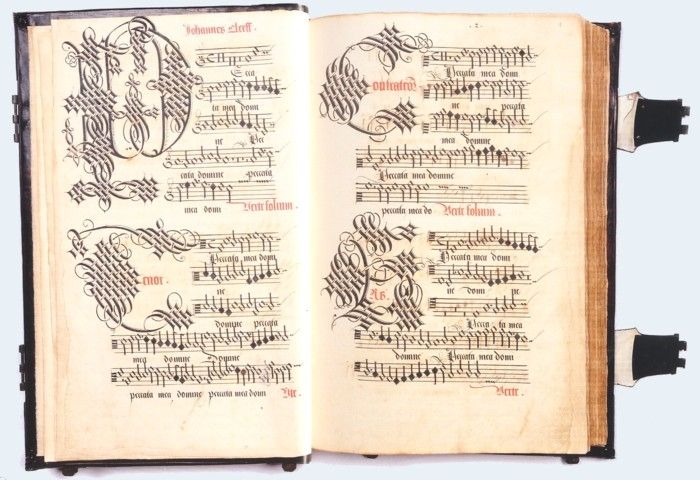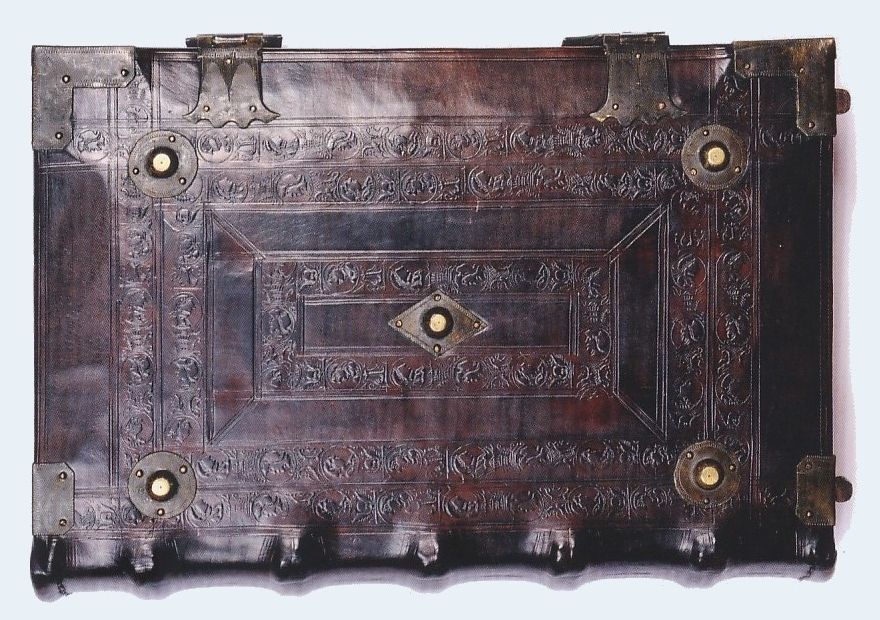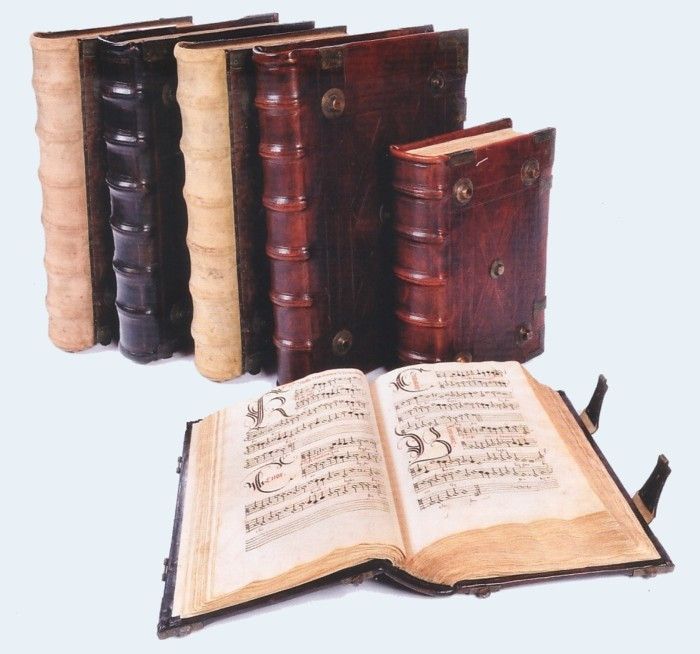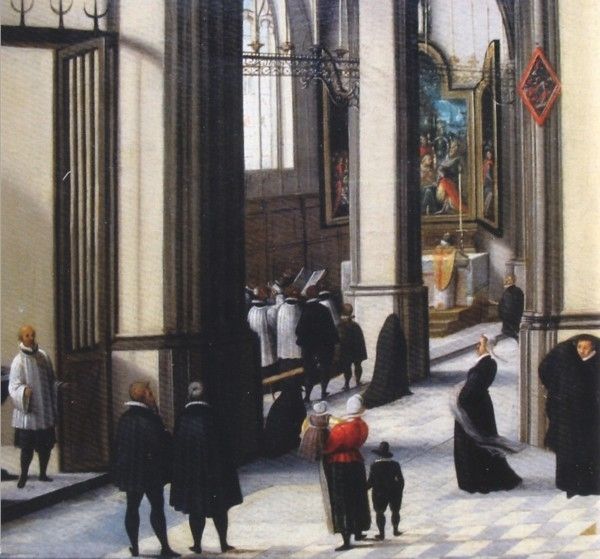

On Friday 19 January 1526 an incident occurred that caused a certain
amount of upheaval in the city of Leiden. The sacristan of the
Pieterskerk found four highly abusive notes posted on the doors of the
church and on the confessional boxes. The contents of these letters
mocked the idea of confession and the not particularly pious way of
life of several members of holy orders there. These epigrams did not,
however, disturb the city fathers unduly, as there was as yet no
question of a powerful reformation movement at that time in Leiden. The
letters were nonetheless taken as a sign of the growing opposition to
the abuses prevalent within the Roman Catholic Church at that time. The
first vehement expression of this opposition that would eventually
result in a transition to Protestantism was the Beeldenstorm or
iconoclastic fury of 1566 that erupted in Leiden on 25 and 26 August of
that year. Disturbed by reports coming from other cities, the
burgomasters of Leiden had arranged a meeting on Sunday 25 August; this
meeting was interrupted by the sacristan of the Pieterskerk with the
news that several people who clearly intended to cause trouble had
forced their way into the church. On their arrival at the Pieterskerk
the burgomasters and pensionaries found two people destroying statues.
The culprits were driven out of the church and the sacristans of the
three churches in Leiden were ordered to keep the doors of the churches
closed. The Leiden militia were organised to guard the churches.
Despite these precautions, the iconoclasts broke into the
Onze-Lieve-Vrouwekerk on the night of 25-26 August; the Pieterskerk
also fell prey to the crowds later the following day. Altars were
desecrated and the marble statues of the twelve apostles that stood on
the pilasters of the choir were destroyed. The iconoclasts were not
able to break down the door of the sacristy, with the result that the
monstrance and other church property were able to be taken into
safekeeping the next morning. When the uproar quietened down on 27
August, the authorities took stock of events: The populace were told
that they would be severely punished if everything that had been seized
or removed from the churches and cloisters was not surrendered and
delivered to the St. Jacobsgasthuis; it was also announced that any
further violence against members of religious orders or their
institutions would be punished with hanging. The three parish churches
were cleaned and put in order so that normal religious observances
could be resumed.
Amongst the most important pieces of church property that survived
these two turbulent days in 1566 were the choirbooks of the College of
the Seven Liturgical Hours of the Pieterskerk. Their survival of the
iconoclastic fury seems to indicate that the manuscripts were carefully
kept somewhere under lock and key in the church. Today, these
choirbooks provide unique and extremely valuable proof of the rich
musical life of 16th-century Holland. Even though musical practice
flourished greatly in Dutch churches in 16th century, extremely little
evidence of this has survived in Dutch archives and libraries. Of the
countless music manuscripts that were used by singers of the liturgical
hours as well as others, only a fraction of these have survived the
ravages of time.
But who were these 'singers of the liturgical hours' and what precisely
was the function of a College of the Seven Liturgical Hours? For an
answer to this question we have to turn our attention to the city of
Leiden in the 15th century. The Pieterskerk was situated in the largest
parish of Leiden: according to a report by its pastor, it counted no
less than 5000 communicants in 1514. The Pancraskerk, Leiden's second
church, followed close behind with approximately 4000 communicants,
whilst the third, the Onze-Lieve-Vrouwekerk, stood far behind with only
some 500 communicants. There was enormous and continuous activity in
the churches: altars were placed from the choir as far back as the
tower and a selection of clergy celebrated Mass at all of them. These
were primarily the pastor and his colleagues, of course, although there
were numerous other clergy occupied there as well. The memoriemeesters
— the administrators of the funds paid to the church for services
for the Dead — of the Pieterskerk employed thirty-four curates
between the middle of the 15th and the middle of the 16th centuries,
whose specific function it was to pray for the souls of the deceased.
It was believed during the Middle Ages that the soul of the deceased
had first to pass through purgatory before being received into heaven.
The soul's entry into heaven could, however, be accelerated by the
prayers of the living. Such prayers for the deceased became a task for
the clergy during the late Middle Ages; people could pay to have a mass
or a memorial service said for their parents, for another man or woman
or even for themselves. The rich, therefore, could have a mass said
once a year, once a month or even once a week. The central part of such
a memorial service was in effect the passage to the grave, with the
preferred psalms for the occasion being Miserere mei Deus
(Psalm 50) and De profundis clamavi (Psalm 129). Such services
were taken not only by the churchwardens and the memorierneesters
but, from the middle of the 15th century onwards, also by the Masters
of the Hours. These last-named are interesting from the point of view
of the history of the Leiden choirbooks, for it was they who ordered
the manuscripts and used them in their services.
The singing of the seven liturgical hours grew enormously in popularity
in the Netherlands during the 15th century. In point of fact, a College
of the Seven Liturgical Hours was simply an imitation of a chapter. In
chapter churches, just as in convents and monasteries, the hours
— also called the Office or choral prayer — were sung:
Matins, Lauds, Prime, Terce, Sext, None, Vespers and Compline. Matins
and Lauds were combined to form the nocturnal office whilst Vespers and
Compline together formed evening prayer. If we count from Matins to
Compline, we have eight hours in total; why then is there this
discussion of a College of the Seven Liturgical Hours? The explanation
is, however, extremely simple: Matins and Lauds were combined into one
service, the nocturnal office, in non-cloistered churches during the
Middle Ages and therefore seven were left over. Parish churches
naturally sought more honour and glory and so imitated the rituals of
the chapter churches. A separate college was then created for the
singing of the Office, be this a few times per year, a few days per
week or even daily. A special college was founded in various places for
the singing of the seven liturgical hours. The first city to acquire
such a college seems to have been Leiden (ca. 1440) with other cities
following rapidly: Rotterdam (1449), Delft (1450-51 in the Oude Kerk
and 1456 in the Nieuwe Kerk), Haarlem (1452), Gouda (1453), Alkmaar
(1456), Amsterdam and The-Hague (1468) to name but a few.

Archives of several of these colleges have survived and their existence
is well-documented in letters of foundation, benefactions and suchlike
transactions. All that we know about a great many other colleges of the
hours, however, is the simple fact that they existed. We can get a good
idea of how such a college was organised from the foundation letter of
the College of the Hours of the Oude Kerk in Delft. The council of the
city of Delft appointed three or four people each year who were
responsible for the administration of the monies and the goods offered
in payment for the Seven Liturgical Hours and also paid the priests
their salary. They were required to appoint seven or eight priests
— more if they found it necessary — who would perform the
rituals of the college. The sacristan was also required to sing with
the priests, unless he had other functions to perform in the church.
The schoolmaster of the Latin School and his pupils were also involved
with the services; music was an important part of education at the
Latin School during the Middle Ages, with the pupils being taught how
to sing Gregorian chant. The schoolmasters had a great amount of work
to do in cities such as Delft and Leiden; they were required to come
with their pupils on the eve of each holy day to sing Vespers and then
Matins, with a Mass and Vespers again on the day itself — this
took place approximately one hundred times per year. Such a burden was
naturally far too heavy for the pupils and their teachers, with the
result that their workload was drastically reduced in 1484.
The priests of the college were required to sing the seven liturgical
hours 'honourably, perfectly and with good manners' each day in the
choir. A mass was also required to be said or sung every day for those
who had donated money or goods to the college.
Not every town or city could boast such a range of devotions; there
were often fewer priests present and Gregorian chant was frequently the
only music to be heard. A tradition of polyphonic music nonetheless
became established in various cities, as was the case in Delft, Gouda,
Rotterdam, Haarlem and, last but not least, in Leiden. Leiden possessed
two colleges of the liturgical hours during the 15th century; the
oldest of these was in the Pieterskerk and the other was in the much
smaller Onze-LieveVrouwekerk.
The earliest reference to the Pieterskerk college dates from 1440. We
can see from the earliest documents that the singing of the Hours
during those years was not yet a permanent fixture. A change in this
came when Boudewijn van Swieten decided to support the singing of the
Hours; van Swieten was highly-regarded in Leiden and had made a
sizeable career for himself in aristocratic circles, finally becoming
treasurer of the court of Holland. Boudewijn had however, despite his
involvement in secular politics, never lost sight of his soul's
salvation. He founded two chaplaincies in the Pieterskerk in 1421 and
in 1427 and seems to have lived opposite the church. He laid down in
his will in 1443 that the money that he had until then given to support
the two chaplaincies was from that date onwards to be used to support
the singers of the College of the Seven Liturgical Hours - all of this,
however, on condition that the Seven Liturgical Hours would be sung
each day in the choir by seven priests, two choirboys and the sacristan
on normal days and with the addition of the schoolmaster and his pupils
on high days and holidays. A mass had to be sung by seven priests daily
at Boudewijn's altar, this being followed by a procession to his grave.
On normal days the seven priests and two Choirs had to recite a Miserere
and a De profundis followed by a Salve Regina after
Compline. The seven priests and two choirboys had to sing a Requiem
Mass on the Mondays that followed days sacred to the Virgin Mary. He
also specified that the chalice and the missal that he himself had
donated were to be used at every service that was held at his altar
situated on the north side of the choir aisle. A final condition was
the requirement that three and later four people be employed to
organise and administer all of the above.
The College of the Seven Liturgical Hours in the Pieterskerk became
steadily more important thanks to later foundations and donations,
although it can be seen from the few surviving documents that its
growth was not spectacular. The body of singers was formed initially by
seven priests and two choirboys, later becoming eight cantors and four
choirboys during the period 1481-1510. The singers and the choirboys
were led by a singing-master. We know the names of fifteen of these who
were active between 1450-1560, of whom the first, master Jacob Tick,
was in many ways the most interesting. Tick was appointed on 1 November
1453 for a period of ten years; his contract of appointment stated that
polyphonic music was to be sung in the Pieterskerk and that he was also
required to give the children music lessons. Parents were required to
pay for this, but if the parents were poor, then Tick was required to
content himself with what they could afford to give. Tick did not serve
his full ten years, for in the meantime he became a bailiff of the Duke
of Burgundy in 1458 and was then appointed singing-master at the St.
Jacobskerk in Bruges in 1463. The other singing-masters in Leiden were
not such high-flyers; we only know the first names of most of them, and
that a few others were also employed in towns such as Gouda, Haarlem
and Rotterdam.
The turnover of singers was very high; this was a cause for such
concern to certain choirs that they resorted to the use of contracts.
The Delft College of the Seven Liturgical Hours signed a contract with
its fellow college in The Hague in which it was agreed that neither
college would employ a singer within a period of two years after he had
left another choir. The appointment of a singing-master was also not
always a real guarantee of quality of musical performance, for there
were regular complaints about the singers' work. Several such letters
of complaint have been preserved in the Leiden archives, in which we
can read that singers arrived late for their choral duties, that they
did not sing the Gregorian chant with the necessary tranquillity but
rather rushed through the music, that they no longer replied with the
traditional Amen or Deo gratias after the precentor had finished, that
they chattered during the services and that they were already changing
out of their liturgical robes while they were still sitting in choir.
Such complaints were not limited to Leiden: there were complaints in
many parts of Holland that the psalms were being sung too quickly and
that the pauses that should be made between the verses of the psalms
were not being observed.
What exactly did these singers of the Hours sing in the Pieterskerk? We
are extremely fortunate that six choirbooks that were ordered for this
purpose in the middle of the 16th century were preserved. They are the
only books of music that have survived from all of the Colleges of the
Seven Liturgical Hours that existed in the Netherlands. We know from
old inventories that comparable manuscripts were used in Haarlem, in
The Hague, in Delft, in Gouda, in Dordrecht and in Rotterdam. The
Leiden choirbooks are therefore the only collection that can now give
us an impression of the repertoire that was sung in these churches. The
six choirbooks — that were marked from A to F during the 19th
century — were clearly made to be used: they were copied onto
paper rather than on expensive parchment, provided with a few decorated
initials letters in black or red ink and contained repertoire that was
intended for general daily use. (illustration 3) Choirbooks A to D are
large in size (ca. 55 x 39 cm) in comparison with books E and F, which
were written on much smaller sheets of paper (ca. 41 x 28 cm). We know
with certainty that manuscripts A to C were copied out by the Leiden
music copyist Anthonius de Blauwe, who had also copied out choir-books
for other localities in Holland. The first mention of his name is to be
found in the account books of the Masters of the Hours in Gouda; we can
see in the sections dating from 1547 that monies were paid out to
'Master Anthonis, living in Leiden'. His name recurs in the accounts of
the Masters of the Hours in Delft from 1547 through 1549. Other
choirbooks prepared by him have been found in Amsterdam, in Dordrecht
and in Rotterdam. The first Leiden choirbook dates from 1549, whilst
the second and third date from 1559. Manuscripts D to F are undated,
but clearly were prepared between 1549 and 1565; they too appear to
contain many pages in Anthonius de Blauwe's hand.

De Blauwe lived on the Vollersgracht in Leiden from 1546 onwards and
was known as a writer and schoolteacher. He was not a teacher at the
Latin School, but ran a school that taught children how to write. He
presumably had no more choirbooks to copy out by 1565, for he was then
appointed to teach orphans how to write, at times in the orphanage and
at times in his own home. The most interesting document concerning de
Blauwe that has survived is a handwritten letter to the singing master
of the College of the Hours in Gouda: here de Blauwe explains that he
had made a splendid choirbook with motets for the singing-master in
Amsterdam and that it had turned out so well that he had decided to
make another copy of it. He then offers this copy to the Gouda college.
Our impression of de Blauwe is of a clever businessman; his true
profession was either writer or schoolmaster, although he earned extra
money by supplying choirbooks.
If we look at the repertoire that de Blauwe was commissioned to copy
out by the Dutch Colleges of the Hours, we see the names of all the
renowned Franco-Flemish composers before us. The first of these was
naturally Josquin des Prés; he had died in 1521 but his music
was of such quality that it circulated throughout Europe until late in
the 16th century. Composers who were contemporaries of the singers are
also represented, with Jacobus Clemens non Papa, Thomas Crecquillon
(singing-master to Charles V), Nicolas Gombert (master of the choirboys
in Charles V's service), Johannes Lupi, Pierre de Manchicourt, Jean
Mouton, Jean Richafort and many others. Works by local composers are
also regularly represented, with singing-masters from Leiden including
Claudin Patoulet (who, as can be seen from a contract from his time in
Haarlem, once turned up drunk when he had to sing), Joachimus de Monte,
Michael Smeekirs and Johannes Flamingus, who added some of his own
works to the choirbooks.
What type of music did these composers write? Primarily polyphonic
masses of course, thirty-three of them in total. In one of the books
— manuscript F —more than twenty different settings of
sections of the mass are notated; these are of course the sections that
make up the Ordinary of the mass — the Kyrie, Gloria, Credo,
Sanctus and Agnus Dei — as they would be the most frequently
used. The Magnificat, the impressive final canticle of Vespers, was
also popular with twenty-five settings, as was the Nunc dimittis with
thirteen different settings. The combined manuscripts contain no less
than sixteen different versions of the Salve regina, this being sung
during the countless services in honour of the Virgin. Alongside all of
these are also around two hundred motets that vary from short hymn
settings that could be performed during the Office to large-scale
Marian motets that were highly suitable for the weekly singing of the
Lof (Salve). A selection of different polyphonic compositions was
therefore available for all the various services that had to be
observed.
An end, however, had to come to the illustrious history of the Dutch
Colleges of the Liturgical Hours, as indeed it did, and with
considerable uproar. What then happened to the Leiden choirbooks? After
the Reformation they ended up in the hands of the Leiden city council.
The council received a request in 1578 that the choirbooks might be
used once again, for there were several enthusiastic singers who wanted
to make music with the aid of the choirbooks and approval was given for
this. This continued for approximately twenty years and then the
choirbooks were returned to the city council once again. They were shut
away in large chests and stored in the trustees' chamber in the city
hall. The next mention of them dates from 1876, when the choir-books
were transferred from the city offices to the Stedelijk Museum De
Lakenhal, where they were placed on permanent exhibition. The museum
had, however, grown so much by 1931 that it could no longer provide
storage for these splendid books. Five manuscripts were transferred
back to the city archives, where they still remain; one of the
manuscripts — Book C from 1559 — is still on display in the
Lakenhal.
Eric Jas
translation: Peter Lockwood
